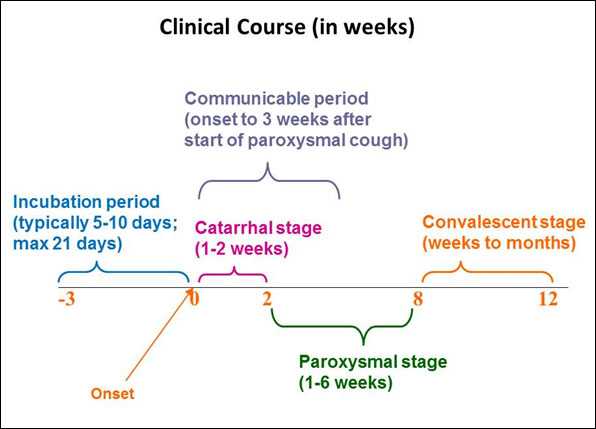Clinical Features
Tips
- Once you diagnose pertussis in a household, consider pertussis in coughing close contacts.
- In the youngest infants, atypical presentation is common. The cough may be minimal or absent and the primary symptom can be apnea.
- Remember, infants are at risk for severe or fatal pertussis. When you suspect a case in an older child, adolescent, or adult, inquire about contact with infants and pregnant women and consider prophylaxis.
There are three stages to clinical course of pertussis:
- Catarrhal
- Paroxysmal
- Convalescent
Pertussis symptoms usually develop within 5 to 10 days after exposure, but sometimes not for as long as 3 weeks. Pertussis has an insidious onset with catarrhal symptoms that are indistinguishable from those of minor respiratory tract infections. The cough, which is initially intermittent, becomes paroxysmal. In typical cases paroxysms terminate with inspiratory whoop and posttussive vomiting can follow.
Paroxysms of cough, which may occur more at night, usually increase in frequency and severity as the illness progresses. The cough typically persists for 1 to 6 weeks or more. The illness can be milder and the characteristic “whoop” absent in children, adolescents, and adults who were previously vaccinated. After paroxysms subside, a nonparoxysmal cough can continue for 2 to 6 weeks or longer.
Unvaccinated or incompletely vaccinated infants younger than 12 months of age have the highest risk for severe complications and death. In infants, the cough may be minimal or absent, and apnea may be the only symptom. Despite increasing awareness and recognition of pertussis as a disease that affects adolescents and adults, clinicians often overlook pertussis in the differential diagnosis of cough illness in this population. Illness is generally less severe, and the typical “whoop” less frequently seen in adolescents and adults. It is important to educate parents to consider pertussis when their child has a cough. Let them know that it can be a severe illness, especially for infants, and they should seek immediate treatment.
| Stage | Length | Clinical Features |
|---|---|---|
| Stage 1: Catarrhal | Usually 7-10 days; range of 4-21 | Characterized by:
|
| Stage 2: Paroxysmal | Usually lasts 1-6 weeks, but may persist for up to 10 weeks | Characterized by:
Paroxysmal attacks:
|
| Stage 3: Convalescent | Usually 7-10 days; range of 4-21 | Characterized by:
Paroxysms often recur with subsequent respiratory infections for many months after the onset of pertussis. |

Related Pages
-
Pink Book's Chapter on Pertussis
Epidemiology & Prevention of Vaccine-Preventable Diseases textbook
-
Pertussis: Recognition and Treatment
CDC Expert Commentary in partnership with Medscape, 3:36 minutes
-
CME: Does This Coughing Adolescent or Adult Patient Have Pertussis?
2010 JAMA article with CME
- Page last reviewed: August 7, 2017
- Page last updated: August 7, 2017
- Content source:




 ShareCompartir
ShareCompartir